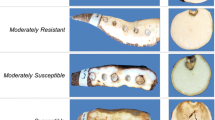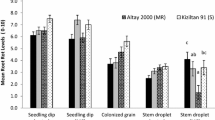Abstract
Fusarium root rot caused by Fusarium solani f. sp. pisi (Fsp) can result in major yield losses in pea (Pisum sativum L.). Currently no fungicides effectively manage this disease. Previous studies evaluated the Pisum germplasm collection for resistance to Fsp, however, evaluations of commercial market classes of pea cultivars grown in the US, and elsewhere, have not been reported. This study evaluated pea accessions and commercial cultivars for Fsp resistance under greenhouse conditions. Accessions evaluated included pigmented lines with high levels of partial resistance to Fsp. Based on root disease severity (RDS) values, the most Fsp-resistant Austrian winter, green fresh, green dry, yellow dry, green winter and yellow winter pea were: PI 125673, 5003, ‘Banner’, ‘Carneval’, PS 05300234, and ‘Whistler’, respectively. Genotypes with a RDS value of 3.05, on a 0–6 scale with 6 being severe, or less had no significant (P ≤ 0.05) reductions in plant height, shoot dry weight, and root dry weight, compared to non-inoculated controls, establishing an important disease threshold value for pea breeders. Plant height, more than shoot dry weight or root dry weight, was the most highly negatively correlated growth parameter related to RDS in repeated tests based on Pearson’s Correlation coefficients. However, root dry weight was also a highly sensitive growth parameter affected by Fsp since 14 of 33 genotypes had significant (P ≤ 0.05) reductions in root dry weight compared to non-inoculated controls, while only 5 of 33 genotypes had significant reductions in plant height and/or shoot dry weight in combined tests.



Similar content being viewed by others
References
Abi-Ghanem R, Bodah ET, Wood M, Braunwart K (2013) Potential breeding for high nitrogen fixation in Pisum sativum L.: germplasm phenotypic characterization and genetic investigation. Am J Plant Sci 4:1597–1600
Basu PK, Brown NJ, Crête R, Gourley CO, Johnston HW, Pepin HS, Seaman WL (1976) Yield loss conversion factors for Fusarium root rot of pea. Can Plant Dis Surv 56:25–32
Chittem KR, Goswami RS, Khan M (2009) Determining efficacy of waste lime in managing Fusarium root rot of field pea. Sustainable agriculture research and education report GNC09-106. http://mysare.sare.org/mySARE/ProjectReport.aspx?do=viewRept&pn=GNC09-106&y=2009&t=2. Accessed 25 April 2014
Chittem KR, Porter L, McPhee K, Khan M, Goswami RS (2010) Fusarium avenaceum as causal agent of root rot in field peas and its control. Phytopathology 100:S25
Clarkson JDS (1978) Pathogenicity of Fusarium spp. associated with root-rots of peas and beans. Plant Pathol 27:110–117
Davis DW, Shehata MA (1985) Breeding for resistance to root-rot pathogens of peas in The Pea Crop: a basis for improvement. In: Hebblethwaite PD, Heath MC, Dawkins TCK (eds) The Pea Crop: a basis for improvement. Mid-County Press, London, pp 237–246
Etebu E, Osborn AM (2010) Molecular quantification of the pea footrot disease pathogen (Nectria haematococca) in agricultural soils. Phytoparasitica 38:447–454
Feng J, Hwang R, Chang KF, Hwang SF, Strelkov SE, Gossen BD, Conner RL, Turnbull GD (2010) Genetic variation in Fusarium avenaceum causing root rot on field pea. Plant Pathol 59:845–852
Feng J, Hwang R, Chang KF, Conner RL, Hwang SF, Strelkov SE, Gossen BD, McLaren DL, Xue AG (2013) Identification of microsatellite markers linked to quantitative trait loci controlling resistance to Fusarium root rot in field pea. Can J Plant Sci 91:199–204
Gatehouse JA, Bown D, Gilroy J, Levasseur M, Castleton J, Ellis TH (1988) Two genes encoding ‘minor’ legumin polypeptides in pea (Pisum sativum L.). Characterization and complete sequence of the LegJ gene. Biochem J 250:15–24
Geiser DM, Jiménez-Gasoc MM, Kang S, Makalowska I, Veeraraghavan N, Ward TJ, Zhang N, Kuldau GA, O’Donnell K (2004) Fusarium-ID v. 1.0: a DNA sequence database for identifying Fusarium. Eur J Plant Pathol 110:473–479
Grünwald NJ, Coffman VA, Kraft JM (2003) Sources of partial resistance to Fusarium root rot in the Pisum core collection. Plant Dis 87:1197–1200
Hadwiger LA (2008) Pea—Fusarium solani interactions contributions of a system toward understanding disease resistance. Phytopathology 98:372–379
Hamid A, Bhat NA, Sofi TA, Bhat KA, Asif M (2012) Management of root rot of pea (Pisum sativum L.) through bioagents. Afr J Microbiol Res 6:7156–7161
Hampton RO, Ford RE (1965) Pea diseases in Washington and Oregon, 1964. Plant Dis Report 49:235–238
Hance ST, Grey W, Weeden NF (2004) Identification of tolerance to Fusarium solani in Pisum sativum ssp. elatius. Pisum Genet 3:9–13
Jung YS, Kim YT, Yoo SJ, Kim HG (1999) Mycological characteristics of Fusarium solani f. sp. pisi isolated from pea, ginseng and soybean in Korea. Plant Pathol J 15:44–47
Kerr A (1963) The root rot Fusarium wilt complex of peas. Aust J Biol Sci 16:55–69
Knopp R, Superko H, Davidson M, Insull W, Dujovne CA, Kwiterovich PO, Zavoral JH, Graham KM, O’Connori RR, Edelman DA (1999) Long-term blood cholesterollowering effects of a dietary fiber supplement. Am J Prev Med 17:18–23
Kraft JM, Berry JW (1972) Artificial infestation of large field plots with Fusarium solani f. sp. pisi. Plant Dis Report 56:398–400
Kraft JM, Pfleger FL (2006) Compendium of pea diseases and pests, 2nd edn. APS Press, Saint Paul
McPhee KE, Chen CC, Wichman DM, Muehlbauer FJ (2007) Registration of ‘Windham’ winter feed pea. J Plant Regist 1:117–118
Mikel MA (2013) Ancestry and characterization of U.S. contemporary proprietary garden pea (Pisum sativum L. convar. medullare Alef.) germplasm. Genet Resour Crop Evol 60:2207–2217
Mukankusi CM, Melis RJ, Derera J, Buruchara RA, Mark D (2011) A screening technique for resistance to Fusarium root rot of common bean. Afr J Plant Sci 5:152–161
Nash SM, Snyder WC (1962) Quantitative estimations by plate counts of propagules of the bean root rot Fusarium in the field soils. Phytopathology 52:567–571
Olson-Rutz K, Jones C, Miller P (2010) Soil nutrient management on organic grain farms in Montana. MSU Extension Service, Montana State University, Montana
Persson L, Bødker L, Larsson-Wikström M (1997) Prevalence and pathogenicity of foot rot pathogens of pea in southern Scandinavia. Plant Dis 81:171–174
Porter L, Coffman VA (2011) Identification of tolerance to Fusarium root rot in wild pea germplasm with high levels of partial resistance. Pisum Genet 42:1–6
Porter LD, Kraft JM, Grunwald NJ (2014) Release of pea germplasm with Fusarium resistance combined with desirable yield and anti-lodging traits. J Plant Regist 8:191–194
Rush CM, Kraft JM (1986) Effects of inoculums density and placement on Fusarium root rot of peas. Phytopathology 76:1325–1329
Sarikamiş G, Yanmaz R, Ermiş S, Bakir M, Yüksel C (2010) Genetic characterization of pea (Pisum sativum) germplasm from Turkey using morphological and SSR markers. Genet Mol Res 9:591–600
Schatz B, Endres G (2009) North Dakota State University field pea production. [http://www.ag.ndsu.edu/pubs/plantsci/rowcrops/a1166.pdf]. Accessed 20 Feb 2012
Tokala RK, Strap J, Jung CM, Crawford DL, Salove MH, Deobald LA et al (2002) Novel plant-microbe rhizosphere interaction involving Streptomyces lydicus WYEC108 and the pea plant (Pisum sativum). Appl Environ Microbiol 68:2161–2171
Weeden NF, Porter L (2008) The genetic basis of Fusarium root rot tolerance in the ‘Afghanistan’ Pea. Pisum Genet 39:35–36
Acknowledgments
The authors would like to thank Virginia Coffman and Tyler McClure, United States Department of Agriculture, Agricultural Research Service, Prosser, WA for help with the greenhouse studies; Brian Bodah, Washington State University, Pierce County Extension for help with greenhouse studies and sampling; Adrian Russell, NZ Plant Research LTD and Bob Arthur, Crites Seed Incorporation for guidance on commercial varieties to be used in this study; Mike Wood, Kurt Braunwart and Chris Braunwart, ProGene Plant Research, for intellectual and financial support and sponsorship. The authors would also like to thank Washington State University Agricultural Research Center Hatch Funds to AD and the United States Department of Agriculture, Agricultural Research Service, for supporting this research.
Author information
Authors and Affiliations
Corresponding author
Rights and permissions
About this article
Cite this article
Bodah, E.T., Porter, L.D., Chaves, B. et al. Evaluation of pea accessions and commercial cultivars for fusarium root rot resistance. Euphytica 208, 63–72 (2016). https://doi.org/10.1007/s10681-015-1545-6
Received:
Accepted:
Published:
Issue Date:
DOI: https://doi.org/10.1007/s10681-015-1545-6




